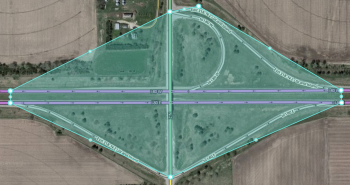When driving on an interstate, it is useful knowing where you are and what exits are coming up. To that end, one solution to this for Waze is to create an area place dedicated to said exit displaying in-app. These exits are conceivably usable for navigation, but serve the primary function of giving users an at-a-glance view of upcoming junctions as they travel, possibly before an exit sign has even come into view.
Standards
In the creation of a Freeway Exit Area Place (FEA) for regions conforming to this standard, the following standards are to be observed:
Drawing
The shape shall be drawn to include the entirety of the outermost ramp segments, fitted to their shape. This gives the most precise shape of the exit area.
 |
 |
Naming
The standard naming structure for an FEA at mile marker 325 would be “Exit 325”. If more than one exit exists within the same mile span such that they are distinct areas and are signed with a suffix, they should be named “Exit 325A” and “Exit 325B”, etc. (or differently if other naming structures are in place for such a situation). Suffixes should not be included in the FEA name if the local system numbers an exit/on-ramp differently based on its direction of travel, such as exiting north on Exit 102N or south on Exit 102S, or each exit is labeled A-D. In these situations, the suffixes should be dropped and the exit area simply named “Exit 325”.
Exceptions and deviations from this rule may be made at the discretion of the state manager(s) or regional management.
Metadata
A Freeway Exit Area place should follow the following standards for metadata:
- Street Address: No House Number; Street, City, and State set to the same as the freeway segments contained in the area
- Primary Category: Junction/Intersection
- Lock Level: Equal to the highest-locked freeway segments contained in the area
Routing Based Information
Information commonly used for navigable places such as Photos, Descriptions, etc. are not necessary, but may be added at the discretion of the editing team.